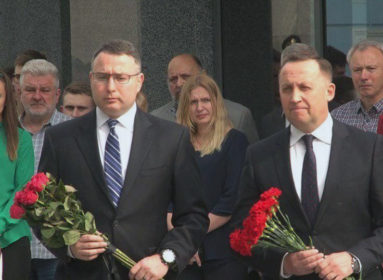
By Cindy Mindell
WEST HARTFORD – The Greek island of Rhodes was once home to a Jewish community that could trace its arrival back to antiquity. Rhodes was one of the central ports that traded with ancient Judea during the Hellenistic period. The island is mentioned in the New Testament by the Apostle Paul among the stops he makes on the Greek islands as a missionary to Jewish communities in the diaspora.
The rich, millennia-old Jewish presence on Rhodes was suddenly cut short during World War II, when the Nazis took over the island and deported all but a handful of the nearly 1,700 Jews still living on the island.
A new exhibition explores this ancient and vibrant culture. “It Was Paradise: The Jews of Rhodes” is part of a year-old archeological excavation led by Prof. Richard Freund, director of the Maurice Greenberg Center for Judaic Studies and Greenberg Professor of Jewish History at the University of Hartford.
The exhibition’s title is taken from one of the interviews that Freund conducted with “Rhodesli,” the Ladino term that Rhodian Jews applied to their community.
“Mr. Benjamin Diliscia gave one of the most poignant interviews about the lives
of the Jews of Rhodes and mentioned to me, ‘It was Paradise, but we did not know it,’” Freund says. “We called the exhibition after these poignant insights on a 2,300-year-old tradition of Jews on the island of Rhodes that is no more but is preserved, in part, by our work in Rhodes and in exhibitions like this.”
The majority of the exhibition includes Ladino books (many published in Rhodes) and personal items, as well as documents on loan from the Rhodes Jewish Museum to the Museum of Jewish Civilization at the University of Hartford.
Freund spoke with the Ledger about his archeological findings so far, and about what the new exhibition brings to light about the unique Rhodesli community.
Q: Why did you go to Rhodes?
A: I started in Rhodes because I wanted to solve what I thought was a simple archaeological issue. It was not. I was asked at a conference why the 16th-century Kahal Shalom Synagogue on Rhodes had two arks rather than one, which is the standard at Corfu, Kos, Thessaloniki, and most Greek synagogues. It is an archaeological mystery that led us back to the origins of Jews on Rhodes and the history of the relations between Ancient Israel and Rhodes as well. This turned out to lead to a massive archaeological and geoscience project with students and faculty members from five institutions. We received rare archaeological permits to explore some of the national treasures of Greece.
Two years later, I now know that we are rewriting the history of the Jews of Rhodes and perhaps even the archaeological record of classical Rhodes.
For example, we know that there was trade between Jerusalem and Rhodes in the Hellenistic period (332-63 BCE), thanks to the discovery of hundreds of Rhodian stamped amphorae in Jerusalem.
During most periods, the Jews were very comfortable and accepted on this small Greek island. But it is and was an island that developed a unique Jewish culture. In the Middle Ages, because of its learned and pious population, the Jewish community was called “La Chica Yerushalayim” —
The Small Jerusalem. The Ladino dialect of Rhodes was unique and rich with Turkish, Italian, Greek, Latin, and the Spanish expressions of medieval Spain. The customs were an amalgam of Spanish, Roman, Babylonian, Judean, and North African customs and rulings; the synagogues were unique and beautifully appointed; the food was both Mediterranean and Middle Eastern; the art of Rhodes combined styles from the Muslims, Templars, Europe, and the Jews of Spain. And then there were the haunting sounds of Rhodes’s popular and liturgical music that echoes the sounds of the mosques, the Greek Orthodox chants, and the Spanish troubadours
Q: How did the “Rhodesli” community evolve?
A: The Jews of Rhodes called themselves “Rhodesli,” a unique designation in Ladino, and unique designation for a unique people. They were not just Sephardim; they were Rhodesli.
Every single Jewish traveler who traveled throughout the Jewish world visited Rhodes. Benjamin of Tudela visits Rhodes in the 12th century and talks in glowing terms of the Jewish community there.
From the 15th century onward, they were basically a subset of Sephardic Jews. In 1492, when the Jews were expelled from Spain, they ended up going to every major port city, including Rhodes. The Jews who were on Rhodes before the arrival of the Spanish Jews after 1492 were probably Romaniot, the Roman ritual Jews. But after 1492, the people who came were so classically Sephardic that Ladino became the lingua franca for the Rhodes community. This is 1522, when the Ottomans took over Rhodes from the Templars and allowed these exiles from Christian Spain to settle on the island. Italy took Rhodes from the Ottomans in 1912, during the Italo-Turkish War
Today, there are very few Jews on Rhodes; I’ve met 10, and many have little to do with the vibrant Jewish life of the early 20th century. It’s very sad, because we’re talking about a population that, in its heyday, represented more than half of what was the Old Town, where everybody lived, inside the ancient city gates. During Ottoman rule, the Jewish quarter thrived: in the ‘20s, there were 4,000 Jews, a rabbinical college, famous Jewish yeshivot, and what we would today call modern Jewish dayschools.
There’s a picture in our exhibition of the Grand Rabbi going to bless the Italian sovereigns in 1929, when Italy ruled the island. It’s such a classic scene, and just shows how the Jews were so intertwined in the community. The Italian leadership on the island came out and thanked the rabbis; they would celebrate holidays together – it was a very positive interaction, both under the Ottomans and the Italians.
Q: What happened to the Rhodesli community in the 20th century?
A: We’re lucky that many Jews left the island in the early part of the 20th century and set up Rhodesli diasporas. A lot of those emigres were part of the regular migrations going on from the 1880s to the 1920s. Some saw the Ottoman Empire as going downhill and wanted to get out when the getting was good. Nobody knew what was going to happen when the Italians came in in 1912. They were seeking economic opportunities; a lot of them were doing international finance so they had connections. It’s lucky for us that they immigrated because they took with them a little piece of Rhodes. We have some great artifacts in the exhibit: pearl-encrusted “Takos,” mikvah “flip-flops” that a bride would wear when she went to the mikvah. We have a rabbi’s suitcase, which he took with him when he went to Los Angeles.
Everything changed with the Nazis. On July 23, 1944, almost 1,700 people were rounded up and taken to the port of Athens and put on trains for the longest journey to Auschwitz – three weeks. By the time they got there, most of them were already debilitated, and there were maybe 150 survivors.

Turkey’s Consul, Selahattin Ülkümen (shown here with his wife), who saved the lives of many Greek Jews in 1944 by including them on a list of protected Turkish citizens. He is included among Yad Vashem’s “Righteous Among the Nations.”
In the exhibition, we showcase the life of one family, the Turiels, who were saved by Turkey’s Consul, Selahattin Ülkümen in 1944. Turkish and Greek Jews were being deported to the death camps from the island of Corfu. But on Rhodes, Ülkümen saved the lives of 42 Jews, whom he included on a list of protected Turkish citizens.
After Italy was defeated by the Allies in 1943, the Nazis took over Rhodes. During Italy’s reign, Mussolini had been protecting the Rhodesli, along with all Jews in Italy and its territories. But as soon as Mussolini was deposed, the fate of the Jews of Rhodes changed dramatically.
Turkish citizens on Rhodes could live there as protected Turkish citizens but a lot of the Jews were starting to be denied citizenship in any place. Ülkümen, a Turkish-Muslim “Oskar Schindler,” is a focus of one part of the exhibition. On July 19, 1944, the Gestapo ordered all of the island’s Jewish population to gather at its headquarters. Ostensibly, they were to register for “temporary transportation to a small island nearby,” but in reality, they were gathered for transport to Auschwitz and its gas chambers. Ülkümen went to the German commanding officer, General Ulrich Kleemann, to remind him that Turkey was neutral in World War II. He asked for release of the Jews, including not only Turkish citizens but also their spouses and relatives, even though many of the latter were Italian and Greek citizens. For example, Boaz Turiel’s mother was a Turkish citizen and her two sons were allowed to take Turkish citizenship, but the father was from Rhodes. Ülkümen gave them four visas and they escaped.
On July 23, the Nazis rounded up 1,673 Jews. German planes bombed the Turkish consulate on Rhodes, killing Ülkümen’s pregnant wife, Mihrinissa, and two consular employees. The Germans quickly detained and deported Ülkümen to Piraeus on mainland Greece and confined him there for the remainder of the war.
Yad Vashem honored him in 1989, but because he was a Muslim, the designation was changed from “Righteous Gentile” to “Righteous Among the Nations.”
I am often saddened when colleagues ask me to detail the events of the Holocaust which are tragic. What they rarely ask about is the grandiose loss of culture to the world. The Jews of Rhodes who were rounded up on that summer day of July 23, 1944 and shipped off to Auschwitz were the repositories of the great cultural intersection between East and West – and that will not easily be restored.
Q: What did you find during your excavations last January?
A: We discovered that there are multiple synagogues built in the same location.
The main synagogues are Kahal Chalom from the 16th century and the Kahal Gadol or Kahal Grande – referred to by both their Hebrew and Ladino names. They were both destroyed probably in 1944 but we’re trying to establish earlier levels of the synagogues so we’re going to be doing excavation probes. There are multiple layers not necessarily because they were destroyed by people, but there are earthquakes in Rhodes every 100 to 150 years. The 16th-century synagogue was probably built on the synagogue that was destroyed in 1481, during a very famous earthquake. There was an earthquake in 1300, one in the 1200s, and one in 1000. We’re working on excavating earlier layers of the synagogues in order to determine what they looked like, and if there are any artifacts that remained from the earlier layers that were buried. We’re using ground-penetrating radar to investigate these lower layers and they we’re doing very excavating pinpoint archeology to excavate the areas where we suspect there might be artifacts.
While we were in Rhodes, we were given a third assignment, which was to find the existence of an earlier synagogue than what the archeological community thinks was the earliest, built in the 12th or 13th century by the wall of the port.
And then we were given a very, very interesting assignment: we were asked to look for the remains of the Hellenistic Wall, the oldest city wall that may have contained “The Colossus of Rhodes,” a very famous 100-foot-tall statue. It was one of the Seven Wonders of the ancient world, along with the Pyramids and the Hanging Gardens of Babylon. It really was a masterful engineering accomplishment, built in the third century BCE, but it was only standing for 56 years – it fell down after an earthquake.
There is an interesting Jewish connection to the statue. The Muslims conquered Rhodes in the seventh century and there is a notation by the conqueror, Muawiyah I, about a taboo held by the local Greeks against touching any of the broken pieces of the Colossus, which had fallen down seven centuries earlier. Muawiyah I says, “What’s the deal here?” and it’s explained to him. He appoints a Jewish contractor to take away all of the bronze from the statue and ship it back to his headquarters in Damascus. The notation says that it took 900 camels to complete the task. We have two letters that survived, that talk about it. So we know that the Jews were on Rhodes then.
We will be going back in March 2016 to continue our explorations and bring back more artifacts for the exhibition.
The opening of the exhibit “It Was Paradise: Jewish Rhodes” will be held on Sunday, Oct. 18, 2 p.m., at the Museum of Jewish Civilization at the University of Hartford, 200 Bloomfield Ave., West Hartford. It will be on display through May 1, 2016. For information call (860) 768-4022.
In conjunction with the exhibit, “Ladinofest” – a concert of Ladino songs performed by Susan Feltman Gaeta and Cantor Sanford Cohn, will be presented on Sunday, Oct. 18, 7 p.m., at The Emanuel Synagogue, 160 Mohegan Drive, West Hartford. The concert is sponsored in part by the University of Hartford’s Maurice Greenberg Center for Judaic Studies, the Korowitz Family Fund, the Avzaradel-Capuano Rhodes Project, The Emanuel Synagogue, and the Jewish Museum of Rhodes. For information call (860) 768-4022 or (860) 236-1275.







 Southern New England Jewish Ledger
Southern New England Jewish Ledger

















